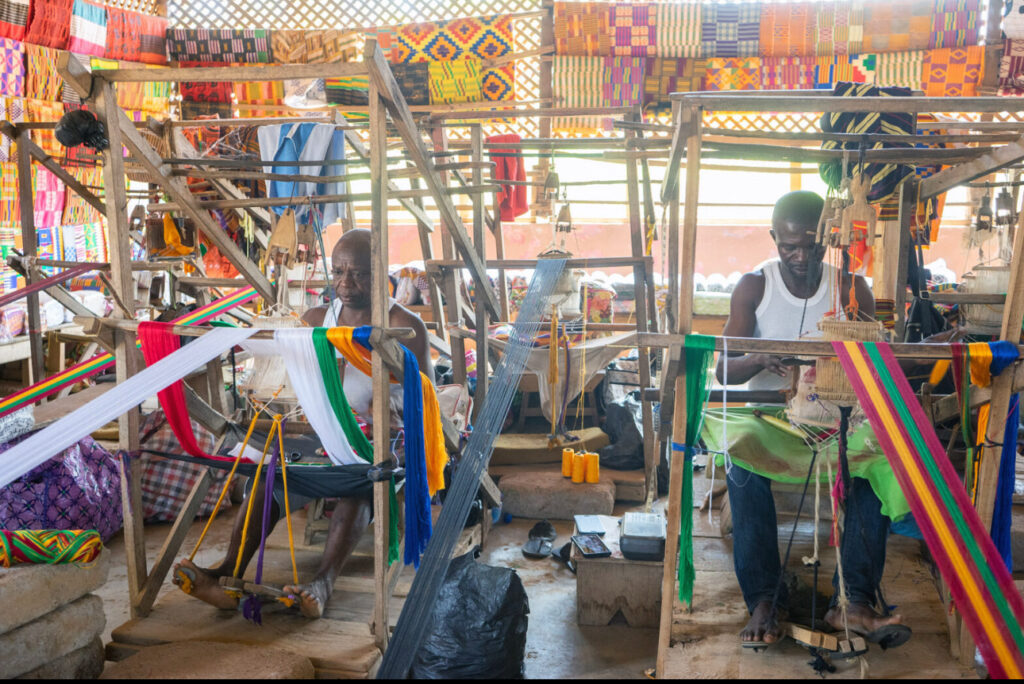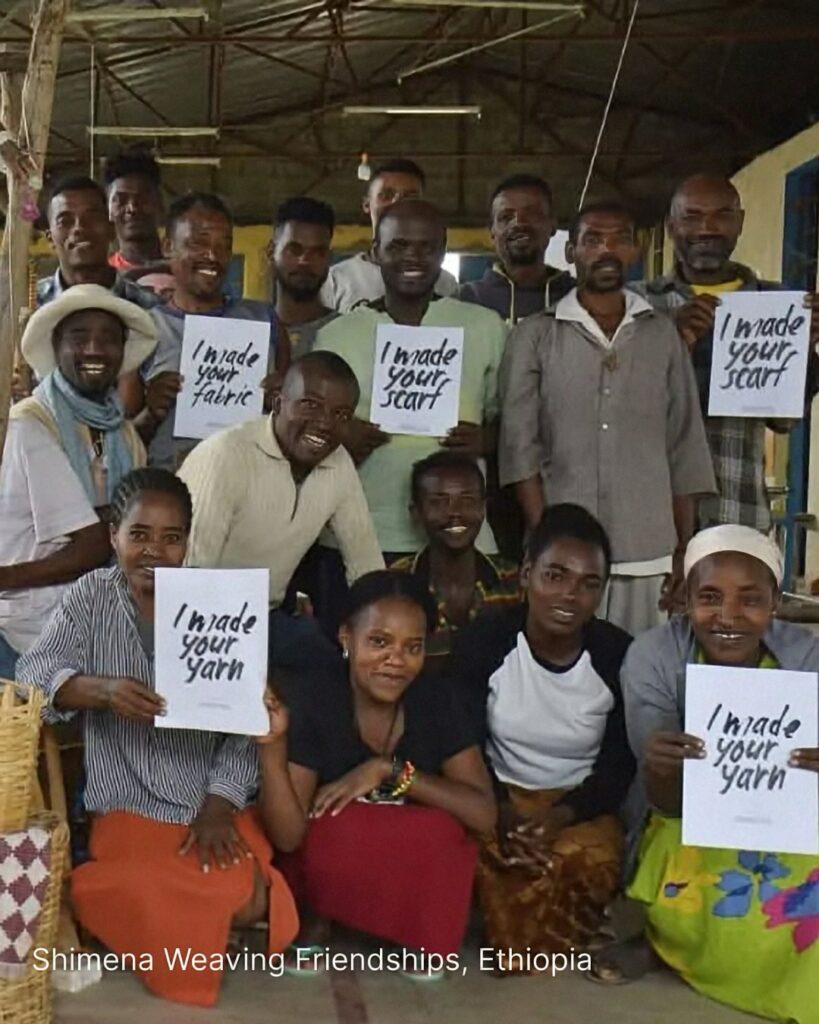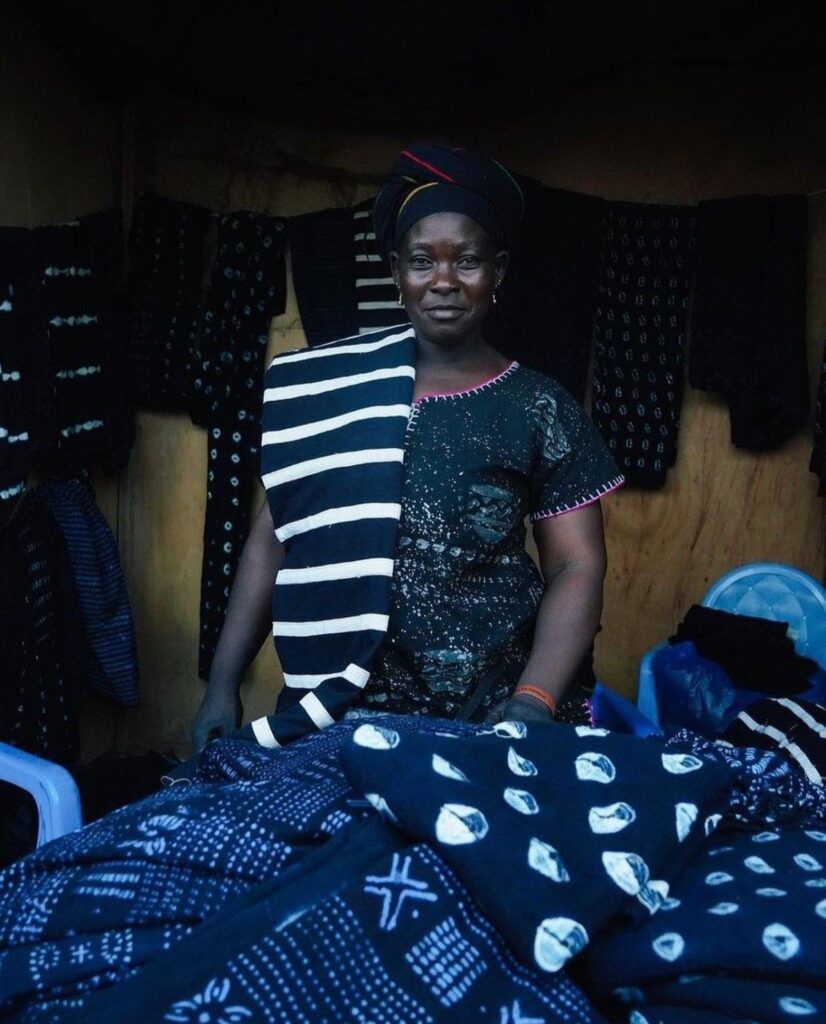
In Ghana’s Bonwire village, kente weavers thread vibrant narratives into silk-cotton cloth. In Ethiopia’s Amhara region, women’s cooperatives spin cotton into minimalist elegance. In South Africa’s KwaZulu-Natal, Zulu beadworkers craft intricate patterns. In Mali’s Bamako region, indigo dyers create mud-dyed bogolanfini. In Kenya’s Kitui County, the Shalom Pride community weaves raffia into sustainable basket bags.
Beyond the spotlight, these artisanal communities—Bonwire, Amhara, KwaZulu-Natal, Bamako, Kitui—are shaping Africa’s fashion story, fueling a $15 billion industry that redefines luxury through collective power. From Ghana’s Christie Brown and Duaba Serwa, showcased through Paris Fashion Week-affiliated events, to Kenyan artisan collaborations through the Ethical Fashion Initiative (EFI), their work graces global stages, blending tradition with sustainability. This is a continental renaissance, woven by communities whose hands challenge fast fashion’s waste and reclaim cultural narratives.
Africa’s fashion industry, projected to grow at a 4.1% compound annual growth rate (CAGR) through 2030, is a creative powerhouse, with textiles and apparel ranked as the second-largest sector after agriculture. In 2025, the global fashion market is valued at $1.84 trillion, but African artisans prove that value lies in craft, not volume. Communities in Ghana, Ethiopia, South Africa, Mali, and Kenya power designers like Thebe Magugu and LemLem, as well as collaborations with global brands like Stella McCartney, which amplify African artisanship.
This piece explores how artisanal communities are driving a decolonized, eco-conscious fashion future—stitching economic empowerment into every thread.
Mali’s Artisanal Communities: Bogolanfini and Global Impact

In Mali’s Bamako region, traditional artisans hand-dye cotton using fermented mud to create bogolanfini, a globally recognized textile. Designers like Awa Meité spotlight bogolanfini in collections presented at Lagos Fashion Week and other international showcases. The West African fashion market is valued at approximately $15 billion (UNESCO, 2025). Stella McCartney’s 2024 collection, inspired by Malian bogolanfini patterns, used vegan prints developed in collaboration with Bamako artisans. Bamako’s chemical-free dyeing practices offer a crucial eco-alternative to fast fashion’s environmental damage, with 70% of artisans reinvesting earnings into education and community development. However, cheap imitations and limited infrastructure—60% cite funding gaps—remain challenges. Platforms like Industrie Africa connect these workshops directly to international buyers, helping preserve Mali’s craft legacy.
Ethiopia’s Artisanal Communities: Cotton and Sustainability

In Ethiopia’s Amhara region, women’s weaving cooperatives produce handwoven cotton for designers showcased at Hub of Africa Fashion Week (HAFW), such as Mastewal Alemu. These artisans also supply LemLem, the brand founded by supermodel Liya Kebede, employing over 65% women and specializing in sustainable, organic cotton production. Ethiopia’s textile sector aims to reach $30 billion in exports by 2030 (UNESCO, 2025). At Hawassa Industrial Park, some artisans use natural dyes and organic methods to produce collections for brands like Metii Gaye. However, low wages ($60–70 per month) and infrastructural challenges like electricity shortages remain significant barriers. Platforms like Ananse Africa, leveraging 69% smartphone-driven web traffic, connect local weavers to global markets. Hub of Africa Fashion Week further promotes traditional Amhara embroidery through brands like Afthoro, showcasing Ethiopia’s capacity for sustainable luxury—with the textile industry growing at a CAGR of over 4%.
South Africa’s Artisanal Communities: Beadwork and Modern Luxury

In South Africa’s KwaZulu-Natal, Zulu beadworking communities craft intricate patterns incorporated by designers like Thebe Magugu, the 2019 LVMH Prize winner. Magugu’s collections at Paris Fashion Week have spotlighted Zulu beadwork alongside Shweshwe textiles sourced from Eastern Cape cooperatives. Organizations such as Woza Moya train over 300 crafters who produce pieces featured at events like South African Fashion Week (SAFW). South Africa’s broader fashion industry, part of a $31 billion Sub-Saharan market, employs around 80% women (African Development Bank, 2025).
SAFW’s digital presentations in 2025 reduce environmental impact, aligning with KwaZulu-Natal’s growing upcycled beadwork initiatives and the resurgence of organic Shweshwe. While cheap imports and limited training remain issues, programs like Fashionomics Africa help bridge gaps, training 65% women participants.
Magugu’s collaboration with Dior, particularly reinterpreting South African heritage motifs, shows the increasing luxury relevance of African artisanship.
Ghana’s Artisanal Communities: Kente and Raffia as Global Icons

In Bonwire, in Ghana’s Ashanti region, kente-weaving families craft silk-cotton textiles on handlooms, embedding motifs of royalty and wisdom. These cooperatives supply luxury African brands such as Christie Brown, whose kente-infused gowns have been worn by A-list celebrities, and Duaba Serwa, whose designs have been featured internationally. Studio 189, based in Accra and co-founded by Rosario Dawson and Abrima Erwiah, employs over 60% women, producing batik and kente fabrics showcased at New York Fashion Week.
Ghana’s apparel market, valued at around $73.59 million in 2025, continues to grow steadily, with e-commerce projected to reach $226.3 million by 2027 (Statista, 2025). In Bolgatanga, women’s raffia-weaving cooperatives fuel brands like AAKS, whose handcrafted bags retail globally at outlets like Anthropologie. Stella McCartney’s 2023 Ghanaian-inspired capsule featured raffia elements sourced through fair-trade collectives.
Challenges persist: approximately 70% of designers cite funding shortages, and Ghana’s Kantamanto Market receives 15 million garments weekly from the global secondhand trade, 40% of which end up as waste.
In response, cooperatives are training youth in slow fashion techniques to sustain kente’s legacy.
Kenya’s Artisanal Communities: Raffia and Ethical Fashion
In Kenya’s Kitui County, the Shalom Pride artisan group weaves raffia basket bags in partnership with the Ethical Fashion Initiative (EFI), launched in 2009 by the International Trade Centre, a joint agency of the United Nations and the World Trade Organization. Employing over 1,000 artisans—mostly women—EFI initiatives promote fair wages, environmental sustainability, and community development. Shalom Pride’s raffia bags are sold in global boutiques, combining Kitui’s weaving traditions with contemporary design influences and contributing to Kenya’s $1.5 billion apparel market (Statista, 2025).
EFI training initiatives empower rural economies, with 80% of artisan earnings reinvested into education, healthcare, and welfare. Challenges include limited access to global markets and rising raw material costs, but platforms like Ananse Africa are expanding their reach. Showcased at Nairobi Fashion Week, Shalom Pride’s success highlights Kenya’s leadership in ethical, sustainable fashion.
The Collective Power: Decolonizing Fashion

Across Ghana, Ethiopia, South Africa, Mali, and Kenya, artisanal communities—Bonwire’s weavers, Amhara’s spinners, KwaZulu-Natal’s beadworkers, Bamako’s dyers, and Kitui’s raffia artisans—are leading Africa’s fashion transformation. Studio 189 supports hundreds of dependents in Ghana. LemLem invests in Ethiopian education. Woza Moya fosters South African artisan employment. Bamako’s workshops safeguard Malian heritage. Shalom Pride enhances rural Kenyan welfare. These communities resist the tide of Africa’s $31 billion fast fashion imports, which see millions of secondhand garments flood markets like Ghana’s Kantamanto each week, with 40% ending up in landfills (African Development Bank, 2025). By championing organic materials and fair trade wages, they are building a sustainable, decolonized fashion future. Culturally, they reclaim and celebrate African narratives. Ghana’s kente challenges stereotypes, echoing movements like Chez Julie’s akwadzan revival in the 1960s. Ethiopia’s cotton, South Africa’s Shweshwe, Mali’s bogolanfini, and Kenya’s raffia craftsmanship assert authenticity and pride. Global collaborations—from Dior x Thebe Magugu to Stella McCartney’s partnerships with Malian and Kenyan artisans—underline the rising global influence of African craftsmanship.
Yet, meaningful change requires luxury brands to invest in training and infrastructure across Africa, following models like Bottega Veneta’s artisanal academy in Italy.
A Renaissance Woven by Communities
Africa’s fashion renaissance is collective, rooted in the enduring crafts of Bonwire, Amhara, KwaZulu-Natal, Bamako, and Kitui. These communities power a $15 billion industry projected to grow to $50 billion with investment in infrastructure and education. Their textiles—kente, cotton, Shweshwe, bogolanfini, raffia—blend heritage, creativity, and sustainability, challenging fast fashion’s massive environmental footprint. Consumers can support this future: buy local, champion brands like AAKS, LemLem, Thebe Magugu, Awa Meité, and EFI-supported groups like Shalom Pride. Amplify artisan stories on social media platforms, where 60% of African designers now find global audiences.
As Africa strides toward a $50 billion fashion future, these artisanal communities remind us: true fashion power lies not in the runway’s glare—but in the hands that weave it.





